CCNA 2 Chapter 1 V6.0 Answers
1. What is the effect of configuring the ipv6 unicast-routing command on a router?
to prevent the router from joining the all-routers multicast group
to enable the router as an IPv6 router
to permit only unicast packets on the router
to assign the router to the all-nodes multicast group
2. Fill in the blank.
When a router receives a packet, it examines the destination address of the packet and looks in the _Routing_ table to determine the best path to use to forward the packet.
3. Refer to the exhibit. PC A sends a request to Server B. What IPv4 address is used in the destination field in the packet as the packet leaves PC A?
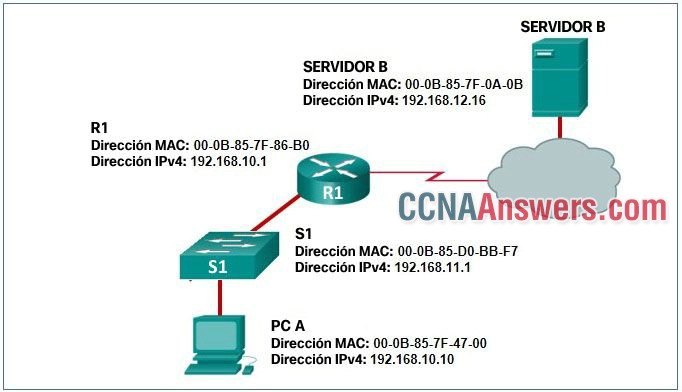
192.168.12.16
192.168.10.10
192.168.11.1
192.168.10.1
4. Refer to the exhibit. If PC1 is sending a packet to PC2 and routing has been configured between the two routers, what will R1 do with the Ethernet frame header attached by PC1?
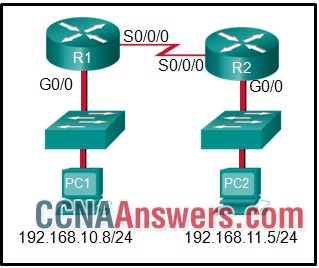
open the header and use it to determine whether the data is to be sent out S0/0/0
nothing, because the router has a route to the destination network
remove the Ethernet header and configure a new Layer 2 header before sending it out S0/0/0
open the header and replace the destination MAC address with a new one
5. Refer to the exhibit. What does R1 use as the MAC address of the destination when constructing the frame that will go from R1 to Server B?
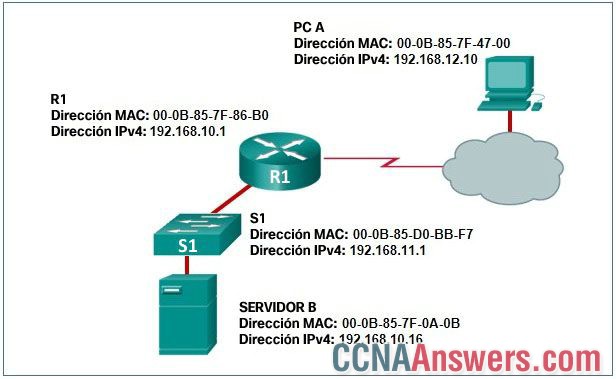
R1 leaves the field blank and forwards the data to the PC.
The packet is encapsulated into a PPP frame, and R1 adds the PPP destination address to the frame.
R1 uses the destination MAC address of S1.
If the destination MAC address that corresponds to the IPv4 address is not in the ARP cache, R1 sends an ARP request.
6. What is a characteristic of an IPv4 loopback interface on a Cisco IOS router?
The no shutdown command is required to place this interface in an UP state.
It is assigned to a physical port and can be connected to other devices.
It is a logical interface internal to the router.
Only one loopback interface can be enabled on a router.
7. Refer to the exhibit. Match the description with the routing table entries. (Not all options are used.)
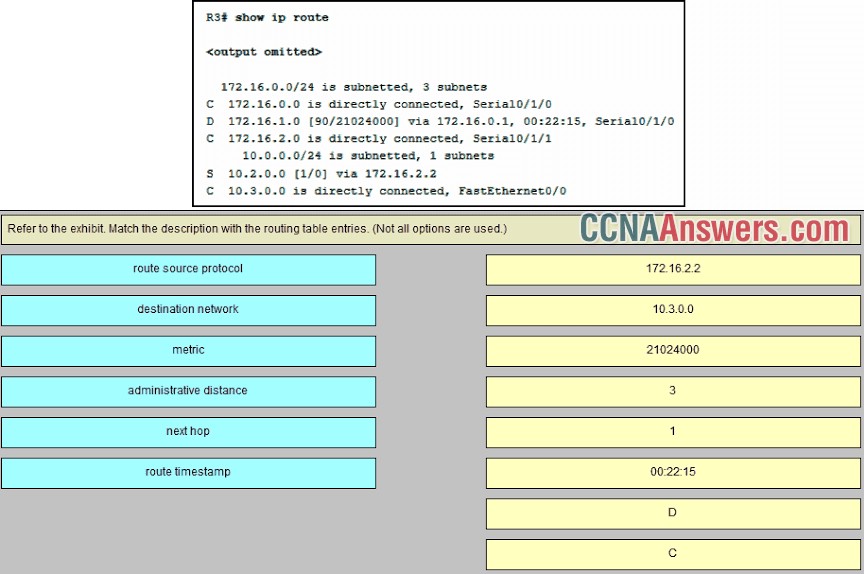
172.16.2.2 -> next hop
10.3.0.0 -> destination network
21024000 -> metric
1 -> administrative distance
00:22:15 -> route timestamp
D -> route source protocol
8. Which two items are used by a host device when performing an ANDing operation to determine if a destination address is on the same local network? (Choose two.)
destination IP address
destination MAC address
source MAC address
subnet mask
network number
9. Refer to the exhibit. A network administrator has configured R1 as shown. When the administrator checks the status of the serial interface, the interface is shown as being administratively down. What additional command must be entered on the serial interface of R1 to bring the interface up?
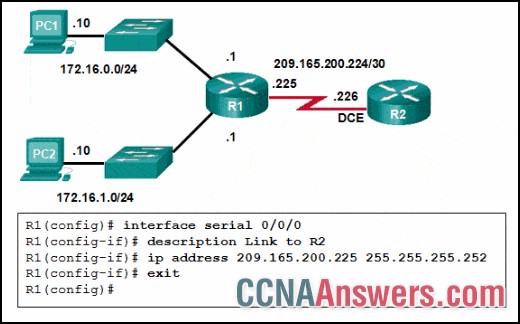
end
no shutdown
clockrate 128000
IPv6 enable
10. Consider the following routing table entry for R1:
D 10.1.1.0/24 [90/2170112] via 209.165.200.226, 00:00:05, Serial0/0/0
What is the significance of the Serial0/0/0?
It is the R1 interface through which the EIGRP update was learned.
It is the interface on the next-hop router when the destination IP address is on the 10.1.1.0/24 network.
It is the interface on R1 used to send data that is destined for 10.1.1.0/24.
It is the interface on the final destination router that is directly connected to the 10.1.1.0/24 network.
11. Which two statements correctly describe the concepts of administrative distance and metric? (Choose two.)
Administrative distance refers to the trustworthiness of a particular route.
The metric is always determined based on hop count.
The value of the administrative distance can not be altered by the network administrator.
A router first installs routes with higher administrative distances.
The metric varies depending which Layer 3 protocol is being routed, such as IP.
Routes with the smallest metric to a destination indicate the best path.
12. Which software is used for a network administrator to make the initial router configuration securely?
HTTPS client software
SSH client software
terminal emulation client software
Telnet client software
13. A network administrator enters the command copy running-config startup-config. Which type of memory will the startup configuration be placed into?
RAM
ROM
NVRAM
flash
14. In order for packets to be sent to a remote destination, what three pieces of information must be configured on a host? (Choose three.)
hostname
DHCP server address
default gateway
subnet mask
DNS server address
IP address
15. Refer to the exhibit. What will the router do with a packet that has a destination IP address of 192.168.12.227?
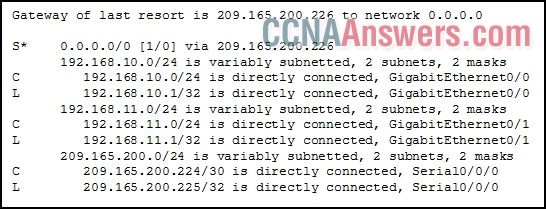
Send the packet out the GigabitEthernet0/0 interface.
Drop the packet.
Send the packet out the Serial0/0/0 interface.
Send the packet out the GigabitEthernet0/1 interface.
16. Which two parameters are used by EIGRP as metrics to select the best path to reach a network? (Choose two.)
delay
jitter
hop count
resiliency
confidentiality
bandwidth
17. Which packet-forwarding method does a router use to make switching decisions when it is using a forwarding information base and an adjacency table?
Cisco Express Forwarding
process switching
flow process
fast switching
18. What route would have the lowest administrative distance?
a directly connected network
a route received through the OSPF routing protocol
a static route
a route received through the EIGRP routing protocol
19. What are two common types of static routes in routing tables? (Choose two)
a static route converted from a route that is learned through a dynamic routing protocol
a static route shared between two neighboring routers
a built-in static route by IOS
a static route to a specific network
a default static route
20. Which two statements correctly describe the concepts of administrative distance and metric? (Choose two.)
Administrative distance refers to the trustworthiness of a particular route.The value of the administrative distance cannot be altered by the network administrator.
A router first installs routes with higher administrative distances.
Routes with the smallest metric to a destination indicate the best path.
The metric is always determined based on hop count.
The metric varies depending on which Layer 3 protocol is being routed.
21. A network administrator configures the interface fa0/0 on the router R1 with the command ip address 172.16.1.254 255.255.255.0. However, when the administrator issues the command show ip route, the routing table does not show the directly connected network. What is the possible cause of the problem?
The configuration needs to be saved first.
The subnet mask is incorrect for the IPv4 address.
The interface fa0/0 has not been activated.
No packets with a destination network of 172.16.1.0 have been sent to R1.
22. Refer to the exhibit. A network administrator issues the show ipv6 route command on R1. What two conclusions can be drawn from the routing table? (Choose two.)

Packets that are destined for the network 2001:DB8:ACAD:2::/64 will be forwarded through Fa0/1.
The network FF00::/8 is installed through a static route command.
R1 does not know a route to any remote networks.
Packets that are destined for the network 2001:DB8:ACAD:2::54/128 will be forwarded through Fa0/0.
The interface Fa0/1 is configured with Ipv6 address 2001:DB8:ACAD:A::12.
23. What are two functions of a router? (Choose two.)
It controls the flow of data via the use of Layer 2 addresses.
A router connects multiple IP networks.
It provides segmentation at Layer 2.
It builds a routing table based on ARP requests.
It determines the best path to send packets.
24. A network administrator configures a router by the command ip route 0.0.0.0 0.0.0.0 209.165.200.226. What is the purpose of this command?
to forward all packets to the device with IP address 209.165.200.226
to provide a route to forward packets for which there is no route in the routing table
to forward packets destined for the network 0.0.0.0 to the device with IP address 209.165.200.226
to add a dynamic route for the destination network 0.0.0.0 to the routing table
25. What two pieces of information are displayed in the output of the show ip interface brief command? (Choose two.)
speed and duplex settings
interface descriptions
MAC addresses
next-hop addresses
IP addresses
Layer 1 statuses


Leave a Reply